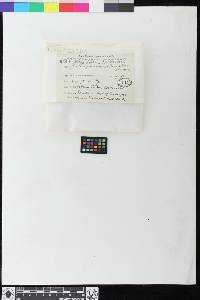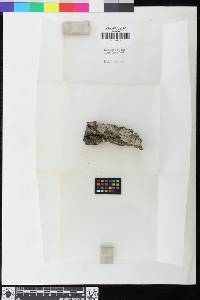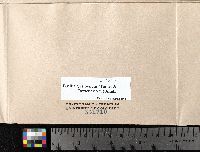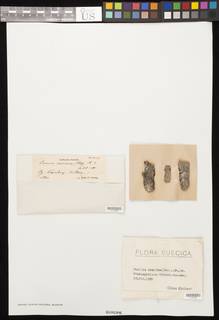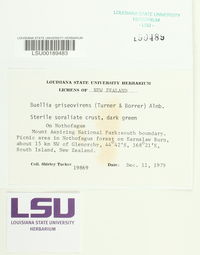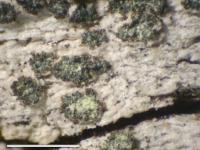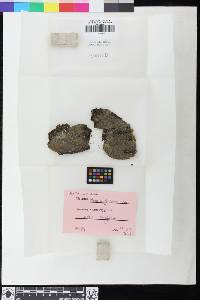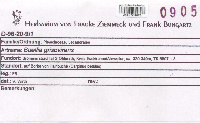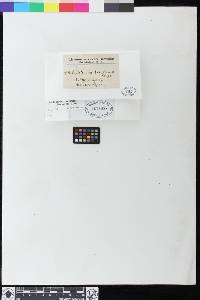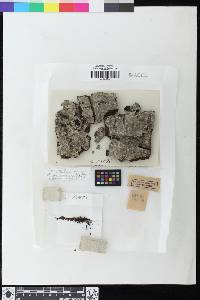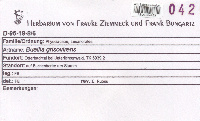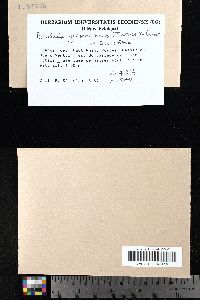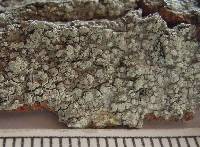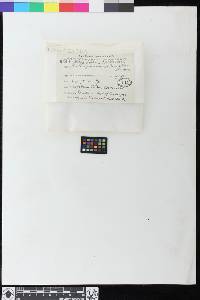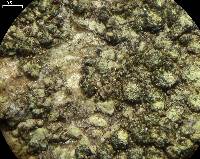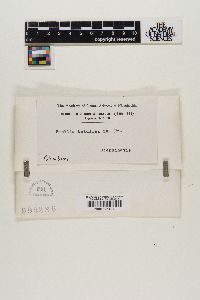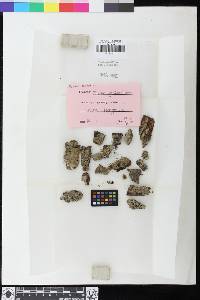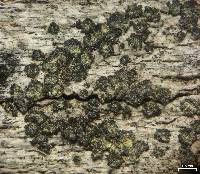
Consortium of Lichen Herbaria
- building a Global Consortium of Bryophytes and Lichens as keystones of cryptobiotic communities -
- Home
- Search
- Images
- Species Checklists
- US States: O-Z >
- US National Parks
- Central America
- South America
- US National Parks
- Southern Subpolar Region
|
|
|
|
Family: Caliciaceae
[Buellia betulina (Hepp) Th. Fr., moreBuellia betulina f. betulina (Hepp) Th. Fr., Buellia betulina f. superreagens Servít, Diplotomma betulinum (Hepp) Arnold, Diplotomma betulinum f. betulinum (Hepp) Th. Fr., Diplotomma betulinum f. superreagens (Servít) Szatala, Lecidea betulina Hepp, Lopadium betulinum (Hepp) Vain., Rhizocarpon betulinum (Hepp) Zwackh, Sporopodium betulinum (Hepp) Vain., Variolaria griseovirens Turner & Borrer ex Sm.] |
Nash, T.H., Ryan, B.D., Gries, C., Bungartz, F., (eds.) 2007. Lichen Flora of the Greater Sonoran Desert Region. Vol 3. Thallus: crustose, rimose to areolate, sometimes endosubstratal; prothallus: pale brown surface: gray, often with a greenish or brownish tinge, smooth or wrinkled, sorediate soralia: usually abundant, discrete, rounded, <0.4 mm, convex, sometimes confluent, grayish white to pale yellow, sometimes with a greenish or bluish tinge; with fine soredia medulla: white, lacking calcium oxalate (H2SO4-) Apothecia: lecideine, sessile, rare, 0.3-1.5 mm in diam. disc: black, epruinose, concave to flat or slightly convex margin: black, thick, persistent, enclosing disc in young apothecia proper exciple: 80-120 µm, lacking secondary metabolites; composed of narrow cells (<4 µm); differentiated into a thin, dark brown outer part, a pale intermediate part, and a dark brown inner part with carbonized cells (HNO3-, K+ yellow), transient with the dark brown, <240 µm thick hypothecium (HNO3-, K+ yellow) epihymenium: brown, pigmentation continuous with the outer exciple (HNO3-) hymenium: hyaline, not inspersed with oil droplets, 80-90 µm tall; tips of paraphyses: ±6 µm wide, with distinct apical caps asci: clavate, Bacidia-type, 65-72 x 19-22 µm, 8-spored ascospores: soon brown, submuriform, with 8-12 cells in optical section, ellipsoid, (16-) 18.3-[20.5]-22.7(-26.5) x (7.5-)8.9-[10.2]-11.5(-13.5) µm, walls and septa lacking uneven thickenings, proper wall c. 0.4 µm thick, perispore <0.15 µm thick, ornamentation: microrugulate Pycnidia: rare, immersed, with uppermost part protruding, wall pigmented in upper part conidia: bacilliform, 4-6 x 1 µm Spot tests: thallus and medulla K+ yellow turning red (crystals), P+ yellow-orange, C-, rarely C+ orange (see Tønsberg 1992) fluorescence: UV-rarely UV+ orange (see Tønsberg 1992) iodine reaction: medulla non-amyloid Secondary metabolites: atranorin (major), norstictic acid (major), connorstictic acid (trace); Tønsberg (1992) also reports griseovirens unknowns. Substrate and ecology: on bark or wood of both broad-leaved and coniferous trees in forested areas at elevations ranging from sea level to 1770 m World distribution: Europe, Mediterranean Africa, Middle East, and North America Sonoran distribution: montane areas of southern California (Riverside and Los Angeles Cos.). Notes: Buellia griseovirens is characterized by its rounded, often greenish or bluish soralia and the thick, prominent margin of the apothecia. When lacking apothecia the species might be confused with other species having similar soralia, such as Fuscidea arboricola, Pertusaria pupillaris, Mycoblastus alpinus, M. fucatus, and Rinodina efflorescens, but these are chemically distinct (see Tønsberg 1992), and only the Rinodina species is known from the Sonoran region. |
Powered by Symbiota






